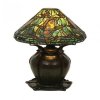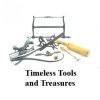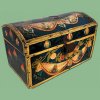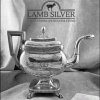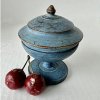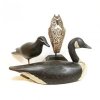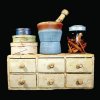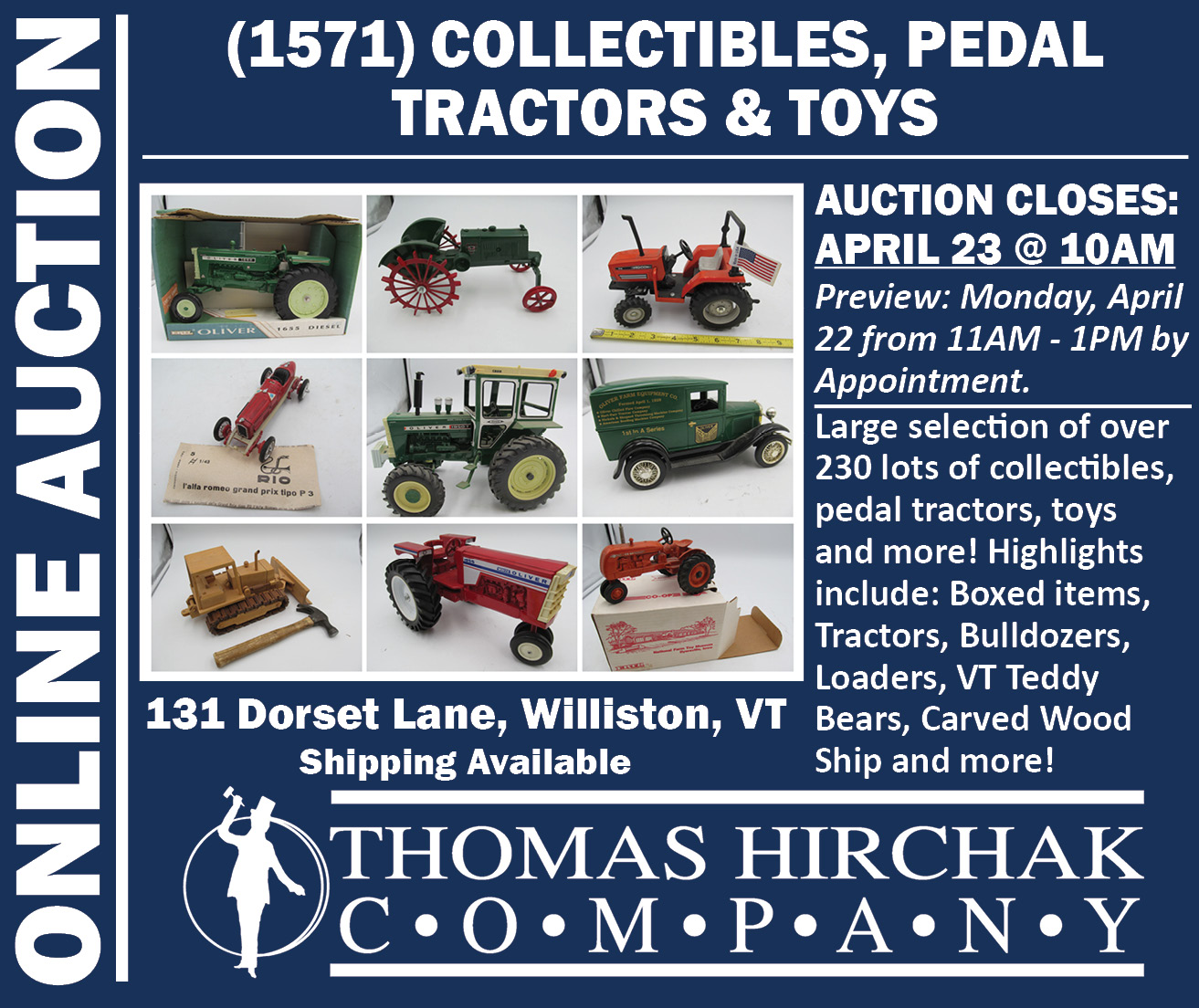Heart of the Shenandoah Valley Antiques Fair
June 20th, 2014
|
Pete Turner hails from Concord, North Carolina, and trades as P & P Treasures. His booth offered an unexpected combination of vintage advertising signs and face jugs. Here is a selection of Turner’s signs: Chicago Southern Transportation Company, $175; Valvoline, $410; NFBPWC, $325; Martin Senour Paints/NAPA thermometer, $100; a square Coke, $225; Quaker State Motor Oil, $130; Lykens Ice Cream, $105; and a Coca-Cola button, $95.
Mary Sparger of Mt. Airy, North Carolina, described the six-drawer storage chest as a “pot cupboard.” The drawers are deep, and several of them are partitioned to accommodate large jars or crocks. The price was $3500. The rocking horse was tagged $1800. The miniature Texaco gasoline pump was marked $250, and the pecking chicks paddle toy was $245. The various leather journals and account ledgers ranged from $75 to $135.
Jerry Ulin of Coleman & May, Annandale, Virginia, offered this array of Native American woven baskets. All of the baskets date from the late 19th and early 20th centuries. They ranged in price from $60 for one of the small open examples to $300 for the larger rectangular baskets on the bottom shelf.
On both days of the show, patrons were treated to live music by the Grim Pickers, an assembled group of musicians from Maryland and Virginia. Every good antiques show has something for everyone. Similarly, the Grim Pickers offered a mix of bluegrass, folk, country, and improv comedy. The group was started 40 years ago by M.A.D. contributing writer Robert Kyle. That’s Bob, second from the left, dazed and confused, but still going strong.
Peg and Mike Jones of Oak Summit Antiques, Williamsburg, Virginia, offered a hinged-lid storage stand, with a single drawer and cabinet below. It was priced at $250. Displayed in the internal bin were a circa 1900 horse-race themed game board, priced at $125; a wooden grain measure for $565; and a large maple bowl, $125. The Joneses reported that this was their most successful show in three years.
Dave and Karen Metcalf of Edgewood Antiques, Greenville, South Carolina, had an array of measuring vessels ranging in size from a half-pint to a quart. They were priced by size, from $110 to $295. The small ones in front `are not marked for volume and were each tagged $35. The pewter flagon at the left was $150.
A major focal point of the booth belonging to Court and Barbara Smith was this somewhat diminutive food safe. The safe is unrestored and in an old mustard yellow surface. The circa 1810 piece has its 12 original punched tins. The safe was priced at $3250. Resting on top of the food safe are a set of scales, priced at $129; a spatterware pitcher, $85; and a mallard duck doorstop, $125. The Smiths trade as Greystone Cottage Antiques and have been located for many years at the Red Schoolhouse in Millwood, Virginia.
G. Allen and Theresa Lee Jackson of Carter’s Cove Antiques, Kilmarnock, Virginia, offered a wide array of interesting items at what seemed to be very affordable prices. This nice dry sink/cupboard was tagged $395. The art pottery included a double bud vase and a basket-form wall pocket, bottom center front, $80 each. Items on the top shelf included a pair of working duck decoys for $95 and $85; a Weller bud vase, $90; and two Roseville bowls, $75 and $85. The center shelf features a Hester Pillsbury decorated vase from Weller, far right, $95, and several Roseville pieces dating from the 1930s, $80 to $165. |
Harrisonburg, Virginia
At a time when the business of staging antiques shows appears to be contracting and realigning within itself, one entirely new event debuted June 20 and 21. Through her show management company, Dordy Fontinel staged the first Heart of the Shenandoah Valley Antiques Fair at the Rockingham County Fairgrounds in Harrisonburg, Virginia.
Many antiques show patrons are familiar with Fontinel. Dordy Fontinel Show Management, Inc. has been staging shows in northern Virginia and Maryland since 1992. For her new event she ventured into the heart of the Shenandoah Valley. Fontinel signed 68 dealers. Most of the dealers were set up inside the fairgrounds’ air-conditioned events center, but some were found on the grassy areas just outside the facility.
This was my first time at a first-time event, and I did not know what to expect. I was curious about how many dealers would attend and what the turnout would be like. On both fronts I was in for a pleasant surprise. The venue itself is large, with enough space for 85 single-dealer booths. The booth space was filled because many of the dealers signed on for double space. There was more than enough additional space for the food vendor and a wine tasting table sponsored by Shenandoah Vineyards of Edinburg, Virginia, and for the eclectic live music band, the Grim Pickers. The Grim Pickers played for both days of the show.
The 68 dealers seemed to offer a good mix, with excellent merchandise in virtually all categories of collecting interests. Fontinel is known as a stickler when it comes to the quality of the antiques that are offered at her show. She insists that her dealers offer only genuine antiques, and they must be willing to sign a contract assuring the authenticity of the items in their booth. For more on Dordy Fontinel’s quest to rid the antiques world of reproductions, fakes, and phonies, see the accompanying sidebar, “Antiques Summit.”
But the number of dealers who sign up and the quality of the merchandise do not necessarily guarantee immediate success. People must come through the doors before there can be any hope of a successful show or the opportunity for sales, follow-ups, or callbacks. Fontinel committed to a heavy advertising campaign for the new show. With traditional print ads, postcards to her mailing lists, and various social media blasts, the word did get out.
During my visit on Friday, there was a good crowd, but not an overflow. Dealers commented that they were not shocked by the turnout but were optimistic that things would pick up on Saturday. According to several conversations after the show, things did pick up on Saturday, and the general feeling was that the new venture was a success.
All the dealers I spoke with stated that they understand that it may take a couple of years for the show to become an established event, but they also expressed unreserved willingness to come back next year.
Fontinel told me that she knows she will be back for another year, but the date is a bit problematic. The Rockingham County Fairgrounds has a longstanding booking for next year, so the dates for the 2015 Heart of the Shenandoah Valley Antiques Fair are still being determined.
For additional information, contact Dordy Fontinel Show Management at (434) 361-1770 or visit the Web site (www.dfshows.com).
Antiques Summit
On May 20, 62 individuals met in Richmond, Virginia, to discuss the future of the antiques business. The group included members of the collecting community, antiques dealers, museum representatives, antiques show promoters, and the press. In her invitation, the meeting’s organizer, Dordy Fontinel, stated the summit’s objective and goal. The objective: “A collective effort designed to address the critical issue facing the antiques world today; [namely] the aging out of the generation that has supported the antiques business for the past 40 years, and the lack of interest in history and antiques by the younger generation.” The goal: “The birth of a national organization to begin the task of publicizing the value and importance of preserving history through antiques.”
To fully appreciate the evolution of Dordy Fontinel’s thinking to reach this point, we must look back over the years. As a show promoter since 1992, she has been a staunch advocate of openness and transparency in the trade. Dealers should stand behind the authenticity of the items that they sell. They should educate their customers, nurturing them as clients and collectors.
In short, Fontinel feels that if one is a professional antiques dealer, one should act in a professional manner. As she sees it, one of the problems is that there are no specific standards within the trade regarding professionalism and accountability. And there is no unified organization to promote and police the trade.
In the absence of any industry-wide standards, she has implemented longstanding strict standards at her own shows. Dealers must guarantee their merchandise; no fakes or reproductions are allowed; and written receipts are required. As a result, she has ruffled a few feathers and has had to withstand personal criticism for her stance against dealers who operate within a “buyer beware” bubble, where the thinking is that it is the consumers who must assume responsibility for research before they buy at a show.
Fontinel is the current president of the Professional Show Managers Association. The Antiques Summit was sponsored by the PSMA and was held in conjunction with its annual meeting. While the notion of professionalism within the antiques trade is not stated as a part of the Antiques Summit’s objectives and goals, it was certainly an underlying constant at the gathering.
The working portion of the summit was divided into a morning and afternoon session. Attendees were divided into small discussion groups for the morning; then they were reshuffled into different groups after lunch. Each group was presented with lists of discussion questions related to various realities facing an antiques business in which the baby boomer collectors are phasing out, and younger millennials do not appear to be stepping in to fill that vacuum.
Those questions seemed to be a jumping-off point for discussion of the general topic but allowed for tangential issues to be raised. The goal was that, at the end of the day, the groups’ ideas would be compiled and act as a framework for future discussion. While the day did not end with any formal compilation of concerns or suggestions, clearly two points did emerge from the day’s activities.
First, there is concern across the board regarding the future of the antiques trade. In fact there was discussion as to whether the business will exist in the future. Jay Gates, a second-generation dealer from Richmond, Virginia, pulled no punches when he summed up his view of the state of affairs within the industry where he grew up: “We have to look at this from a business point of view. We have to set aside our egos, which is not easy. We need each other now, or we will not survive.”
The second and more perplexing point is in identifying who will be the antiques patrons of the future, and how they will interact with the business. Some attendees expressed the opinion that it is a matter of education. Younger people are no longer taught history as they were in the past, and if an appreciation of antiques is developed as a window on that history, that will cultivate new patrons and collectors.
The antithesis of that view was expressed by those who believe that the old collector is going the way of the dinosaur, and the younger generation will never be educated to become old-style collectors. They see the new generation’s appreciation of antiques as yet undefined but feel that there is virtually no chance of younger enthusiasts amassing large collections of such things as stoneware, quilts, or woven baskets based on nuanced differences among examples of the same item. Those sharing this second view see a greater degree of selectivity and specificity in the collector of tomorrow.
Regardless of whether one or a combination of these views will come about is open to endless debate. One point on which all of the summit’s participants seemed to agree is that social media, however it may be defined now and in the future, will be one of the major factors in the antiques business. Dealers and show managers who do not understand and embrace those technologies will themselves be the industry’s dinosaurs.
By the close of the summit, there was agreement on the fact that there is a need to formalize efforts within the antiques community to preserve the business going forward. That formalization may be a national association. The attendees selected a preliminary steering committee from among those present. The assignment for that group is to pull together the various thoughts expressed during the day and to arrive at a recommendation for how to proceed.
In an e-mail the week following the summit, Fontinel asked to be contacted by anyone interested in serving on the permanent steering committee. Her request was to ensure that the committee has the “right strategic balance of skills and vantage points.”
 Antiques professionals are certainly among the most independent business people that exist. When thinking about garnering their agreement and support regarding the direction of the business and the methodology for getting there, one immediately recalls the old saw about herding cats. But having been in attendance at Dordy Fontinel’s Antiques Summit I am encouraged that this herd of cats may at least be headed in the same direction.
Antiques professionals are certainly among the most independent business people that exist. When thinking about garnering their agreement and support regarding the direction of the business and the methodology for getting there, one immediately recalls the old saw about herding cats. But having been in attendance at Dordy Fontinel’s Antiques Summit I am encouraged that this herd of cats may at least be headed in the same direction.
If you are interested in participating in the project, contact Fontinel through her Web site (www.dfshows.com).
Originally published in the September 2014 issue of Maine Antique Digest. © 2014 Maine Antique Digest

